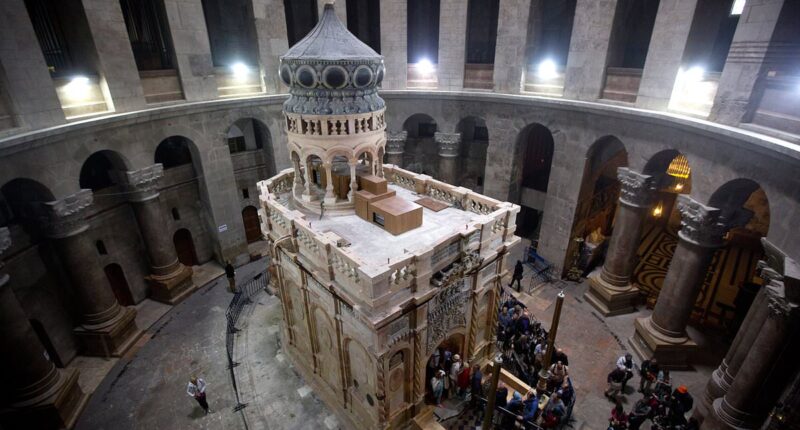An archaeological discovery at the site where Jesus is believed to have been buried may provide new evidence supporting the Biblical account.
Researchers discovered traces of an ancient garden underneath the Church of the Holy Sepulchre in Jerusalem, a finding that they believe corresponds with a passage from the Gospel of John.
According to John 19:41, it is written: ‘Now in the place where he was crucified, there was a garden; and in the garden a new sepulcher, wherein was never man yet laid. There laid they Jesus.’
A group of researchers from Sapienza University of Rome examined plant remnants found at the location and determined their age to be from the time before Christ, placing them in the period of Jesus’ crucifixion and burial, which historians generally estimate to be around 33 AD.
Francesca Romana Stasolla, lead archaeologist, told The Times of Israel: ‘The Gospel mentions a green area between the Calvary and the tomb, and we identified these cultivated fields’
The discovery adds to the ongoing debate over the location of Jesus’ burial.
Many scholars support the Church of the Holy Sepulchre as the site, citing the presence of rock-cut tombs from the first century.
Others argue that the Garden Tomb, another ancient burial site in Jerusalem, better matches biblical descriptions.

Archaeologists found remnants of an ancient garden beneath the foundation of the Church of the Holy Sepulchre in Jerusalem , which they said corroborates the Gospel of John

There is a long-held debate over where Jesus was laid to rest. Some say the church while others believe he was put inside an ancient rock-cut tomb, known as the Garden Tomb (pictured), which aligns with Biblical text
Excavations began during renovations of the church in 2022, but the team recently found what ‘showed evidence of the presence of olive trees and grapevines from around 2,000 years ago.’
However, they have yet to complete radiocarbon testing that is done to determine the age of samples by measuring the decay of carbon-14 (14C) isotope.
Carbon-14 is absorbed into tissue when something dies, including plants, and changes over time, allowing scientists to calculate an exact time for when it was living.
The site of the Church of the Holy Sepulchre sees around four million visitors each year.
The church, which exceeds nearly 5,400 feet in diameter, was built on top of a Roman temple dedicated to the goddess Venus in 335AD.
The construction was commissioned by Roman emperor Constantine I and, during the conversion, a tomb was uncovered that is believed to be that of Jesus who died nearly 300 years earlier.
According to Stasolla, the hidden layers beneath the church’s floor have revealed new details about the history of ancient Jerusalem.
‘The church stands on a quarry, which does not surprise us because a vast part of the Old City of Jerusalem stands on a quarry,’ he told The Times of Israel.

Archeologists were excavating the floor of the church (pictured) when the uncovered signs of an ancient garden that is mentioned in the Bible as where Jesus was laid to rest
‘The quarry was already active in the Iron Age. During the excavation, we found pottery, lamps, and other everyday objects dating back to that period.’
Once the quarry stopped operating, the area was used for framland.
‘Low stone walls were erected, and the space between them was filled with dirt,’ said Stasolla.
‘The archaeobotanical findings have been especially interesting for us, in light of what is mentioned in the Gospel of John, whose information is considered written or collected by someone familiar with Jerusalem at the time.’
In addition to farmland, the ancient quarry was also repurposed as a cemetery with tombs carved into rocks.
Stasolla suggested that Constantine knew which tomb was Jesus’ and built the church on top to isolate it from surrounding burials.
The team also uncovered a circular marble base beneath the shrine encasing what is believed to be Jesus’ tomb.
They will conducted more tests to determine the age and origin of the marble.
In July 2024, archaeologists from the Austrian Academy of Sciences (OeAW) announced a ‘sensational’ discovery made at the Church of the Holy Sepulchre.
The found an alter that went missing when the church was caught fire in the 1800s.
The stone, eight feet long and five feet wide, was decorated with ribbon ornaments, a Roman practice during Medieval times, and distinct markings which lead researchers to believe it was the altar consecrated in 1149.
The slab was found inside the church, but the the front-facing portion was covered in graffiti from tourists. Researchers suspected that is why it went unnoticed for centuries.
However, the unusual decorations on the wall-facing side led the researchers to the so-called ‘Cosmatesque.’
‘This special production technique for marble decoration was practiced exclusively by guild masters in papal Rome, who passed the skill down from generation to generation,’ the team shared.
‘A characteristic feature of this technique was its masters’ ability to decorate large surfaces with small quantities of precious marble.
‘In medieval Rome marble was mainly scraped from ancient buildings, forcing the Cosmatesque masters to optimize whatever marble they could find.
‘Their solution was to put small marble pieces together with the utmost precision, attaching it in such a way as to create complex geometric patterns and dazzling ornaments.’
Cosmatesque artworks are deemed as being cherished by the Pope, so much that rarely any have been found outside of Rome and only one in Westminster Abbey has been found outside of Italy.
‘The Cosmatesque altar now rediscovered in Jerusalem must also have been created with the Pope’s blessing,’ said the researchers.
‘By sending one of the Cosmatesque masters to the Kingdom of Jerusalem to make the new high altar in Christianity’s holiest church, the Pontiff supported Christianity’s claim to the city.’

















